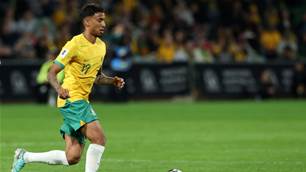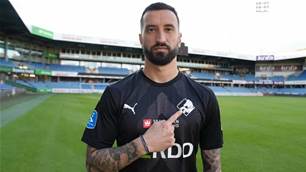As Harry Kewell edged another year closer to 40 yesterday, it’s hard to believe it’s been 11 years since his heroics against Croatia changed the Australian football landscape.
77th minute. Tick, tick. 78th minute. Tick, tick.
Beads of sweat - half water, half German beer - gather before drooling down the crevass-like wrinkles on overweight Australian foreheads. Inflatable Kangaroos are held in death grips. A cross bends through space and time, curling like the flick of a scorpions tail, taking an age to find it's target. The right target.
"Australia's golden boy has done it," screams Simon Hill. Australia already knew. Who else to lead Australia to unforseen heights in world football, then the man who had been doing it his whole career.
But while that World Cup equaliser against Croatia is the moment that lives on in the memories of most Socceroos fans, the man voted Australia’s Greatest Ever Footballer had already catapulted the Australian game to new heights long before 2006.
On his 39th birthday, as he struggles to save a cataclysmic Crawley Town from non-league wilderness and it’s own financial meltdowns, a couple of deserved tributes reminded us all why Kewell's legacy is so important to Australian football.
274 #PL apps
— Premier League (@premierleague) September 22, 2017
57 goals
38 assists
Happy birthday, @HarryKewell 🎂🎉 pic.twitter.com/TSqOsHoIFD
🎉
— Crawley Town FC (@crawleytown) September 22, 2017
Happy Birthday to our Head Coach @HarryKewell - who's 39 today! 🔴 pic.twitter.com/UMmOoZVzMO
Success arrived very quickly for Kewell. He had his first successful trial with Premier League powerhouses Leeds United at 15-years-old.
There is always luck involved in any Australian succeeding in Europe. Brett Emerton, an equally quick and spirited midfielder, if not perhaps quite as skilled on the ball, had also been accepted by Leeds. But Emerton could not satisfy English visa requirements, and Kewell had his father’s English heritage to fall back on.
That small step would be the making of a legend. By 17, he’d hit the first team at Leeds and debuted for the Socceroos – the youngest ever debutant at the time.
At 19, he’d scored in a World Cup qualification play-off, in front of 128,000 people in Tehran. The heartbreak of Australia’s two-legged defeat to the Iranians had a deeply felt effect among the group.
Losing in such acrimonious circumstances in front of 98,000 passionate fans at the MCG - when the National Soccer League in Australia would struggle to get 5,000 to a game - ate at the Socceroos psyche, and led to the lowest morale surrounding the game in Australian history.
But for Kewell, it was a lesson. If he wanted to taste success throughout his career, he’d have to earn it off his own back. At 21-years-old, he had his breakthrough season at Leeds, winning the PFA Young Player of the Year.

Interest from the likes of Barcelona and Manchester United followed – in truth, everybody wanted him – he had grabbed the mantle of Australian golden boy, a title he would hold close until his retirement.
He chose the club he supported as a boy, Liverpool FC. But things were never quite the same after he left Leeds, injuries struck while changes of manager and personnel at Anfield never complimented an extended rehabilitation.
He did however, win the UEFA Champions League in 2005, an oft-forgot accomplishment in the annals of Australian sporting history. He started in that match, was injured within the first half, and was booed off the pitch by unforgiving Liverpool fans. His Liverpool career never truly recovered from there.
From 2008 until 2011 he had an early twilight to his career, rediscovering his form and love of football at Turkish club Galatasaray, where he was warmly embraced by the fans and enjoyed three largely-injury-free years. At 33, Kewell returned to Australia with Melbourne Victory.
Had it been another player, it would have been a very respectable age to return. Had it been another player, there may not have been the pressure that was placed on Kewell.
It was almost as if he had the competition’s sustainability on his shoulders, and while his first season was successful, a highly paid move to Qatar, followed by a far less impactful return with Melbourne Heart, slightly soured the Australian’s aura back home.
It was homecomings like Kewell’s – perhaps unfairly immortalised by a disastrous penalty kick for Melbourne Heart – that characterised the opinions on returning for the likes of Mark Bresciano and Mark Schwarzer. The risks, they cited, outweigh the benefits.
Following the 2006 World Cup, Kewell had one genuine international highlight.
He was overshadowed by Mark Viduka and Graham Arnold’s tactical misery in the 2007 Asian Cup, and was sent off against Ghana in the 2010 World Cup, a mistake that perhaps summarised the blunder of a tournament that still promising Socceroos lineup had.
But in 2011, Kewell shone for the Socceroos one last time in a major tournament. He led Australia to a heartbreaking final defeat against Japan, but was deservedly named in the tournament’s best XI for his efforts.

Now, Kewell is coaching in England, a destiny that many feel is as unsurprising from Harry as a quick drop of the shoulder, followed by a low driven shot from the left flank. He was never going to tough it out learning the ropes in the A-League, and besides, he feels he has unfinished business at Liverpool, and he's made it abundantly clear the hot seat at Anfield is his intention.
Whether Klopp should be concerned – Kewell was sacked by Watford’s u/21 side for poor results, and has an unenviable 20% win record at Crawley Town – is unclear, but regardless of his legacy in England, he’ll always be a messiah for Australian footballers making the pilgrimage towards the English Premier League’s chosen land.
Related Articles

Socceroos midfielder embraces move to England

Cardiff City snap up sought-after Socceroos starlet













